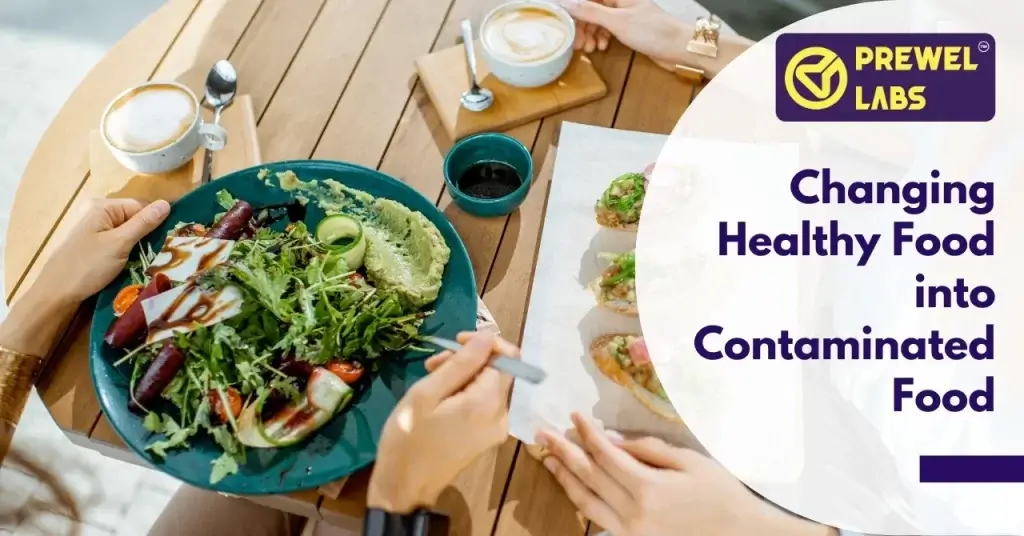Contaminated Food and your Well Being
Food is vital for the sustenance of life. Consumption of healthy food is crucial across all age groups to keep the body healthy. A balanced diet helps overcome malnutrition and ensures proper development in children. Healthy food boost immunity helping us fight many communicable diseases. On the other hand if we consume contaminated food it makes us fall sick quite often affecting our daily lives.
A healthy and balanced diet along with physical activity has enormous health benefits. It brings down the risk of several diseases such as diabetes, cardiovascular, gastric disorders and cancer. The benefits of a healthy uncontaminated diet gets reflected with better immunity in children. It enhances work productivity, promotes good health and long life.
1 out of 10 people – fall sick due to the consumption of contaminated food & globally every year around 4,20,000 deaths occur.– World Health Organisation (WHO) estimate 2020
Types of Food Contamination
Various factors influence the quality of food. These are the properties of the food, source, production, processing and storage environment, shelf life, and so on. Food gets contaminated due to chemicals, microbes and environmental contaminants, adulteration, or toxic heavy metals.
Microbial Food Contamination
The food we eat is rarely sterile. It may have abundant microorganisms such as viruses, bacteria, parasites or their toxins. They cause food spoilage or diseases. Consuming contaminated food results in food-borne illnesses such as food poisoning as well as serious disease outbreaks.
Chemical Food Contamination
Food and food products can get contaminated with hazardous and toxic chemical substances. These include agrochemicals, pesticides, environmental chemicals, cleaning and sanitizing agents. Packaging agents, preservatives, ripening agents can also be present as chemical contaminants. Their presence in food causes serious toxic effects. The consumers become victims of various types of diseases including cancers.
Food Adulteration
This is the addition of prohibited substances to food for financial gains. The intentional addition of adulterants such as soil, marble chips, stones, water, coal tar, dyes, mineral oil, chalk powder, detergents, etc. Unintentional adulteration is when chemical pesticides and metallic substances are added during food processing leading to contaminated food. Accidental adulterants include pesticides, rodent droppings, insect larvae, that occur in food during improper storage (Ameeta et al., 2017).
Food Standard Failure & Quality Loss
Food can get contaminated at various stages from farm-to-fork. Environmental factors, careless and improper handling, unhygienic processing, improper storage and packaging or during transport. Toxic chemical pesticides in food have adverse effects on human health. This is an issue of great concern. Pesticide residues found in food are higher than the permissible limits. Further, food adulteration is a fraudulent activity always making daily the headlines. It brings down the quality of food and increases the risk to the consumer’s health. Microbes, adulterants or pesticides are not discernible. The food, thus consumed without objection can result in adverse consequences.
Unsafe Contaminated Food – A global threat
The safety, security and nutritive value of food are all linked. Food is unsafe when it contains harmful microbes or chemical contaminants. The intake of unsafe contaminated food results in over 200 diseases. These include diarrhoea, foodborne outbreaks, long-term health effects and life-threatening cancers. Contaminated food poses risk to all age groups- the young, children and old. Malnutrition in infants is an added burden (Hussain 2016).
Scope of the Problem
By the year 2050, there is a need for drastic transformation in the strategies of production, processing, & trading of food and food products (FAO, 2021). Feeding the ever-increasing population is a challenge. Addressing issues of increased food production should not compromise the nutritive value, quality and safety of food.
This is of utmost importance to the consumers. There are several reasons why people do not get access to adequate, nutritious and safe food. Food contamination is a global issue. Majorly developing and low-income countries face this challenge. Consumption of contaminated food results in the death of millions worldwide. It results in simple to severe diseases affecting the socio-economic status of nations.
Food Safety Testing
A Way to Overcome these Challenges
Ensuring enough and safe food is of top priority for all stakeholders. This involves households, eateries, food industries, the agricultural sector and regulatory bodies. Food safety, security and nutrition are important for the well-being of future generations. Reliable, rapid, cost-effective and efficient protocols help to determine food safety.
They detect microbial, chemical contaminants, adulterants and the nutritive value of food. These include physical, biochemical, microbiological, immunological, molecular and other emerging technologies. They assess the quality, value of food, food authentication as well as consumer protection (Sangita et al., 2017). Testing the safety of food also helps design food safety management strategies. This depends on the nature of the contaminant, source, and consumer risks. These assessments help improve the quality of food complying with regulatory standards.
Send us a message or call us at +91 6366942390 and we’ll be there to ensure your food has no harmful contaminants.
We test food for microbes, adulterants, hygiene monitoring, as well as determine its nutritive value and shelf life. Food safety testing procedures guarantee “Safe and Nutritious food” which is crucial for sustainable life and good health.
Connect with our Food Testing experts in Bangalore!
References
https://www.who.int/news-room/fact-sheets/detail/food-safety
http://www.fao.org/food-systems/our-approach/en/
Sangita B, Apoorva S, Manisha M and Anupam K. M and Sanjiv K. (2017) Food adulteration: Sources, health risks, and detection methods. Critical Reviews in Food Science and Nutrition, 57 (6), 1174-1189. https://doi.org/10.1080/10408398.2014.967834
Hussain M. A. (2016). Food Contamination: Major Challenges of the Future. Foods (Basel, Switzerland), 5(2), 21. doi: 10.3390/foods5020021
Ameeta S, Neha B, Anjali G and Ankita S. (2017). Food Adulteration: A Review. International Journal for Research in Applied Science & EngineeringTechnology. 5 (3), 686- 689.

